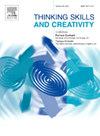Release from (creative) proactive inhibition: Can we manipulate divergent thinking the same as memory?
IF 4.5
2区 教育学
Q1 Social Sciences
引用次数: 0
Abstract
Creative ideation is influenced by spontaneous associative processes and cognitive fixation. Within generating ideas from a similar conceptual (semantic) category, memory retrieval can cause fixation through output interference, leading to fewer novel ideas. However, an incubation interval or new context can facilitate such a memory retrieval process, thus leading to the generation of more novel ideas. Proactive inhibition (PI), a phenomenon rooted in memory research, disrupts the retrieval of new learning due to prior experiences. Release from Proactive Inhibition (RPI) involves a memory rebound when switching between semantic categories, leading to an increase in the semantic distance between responses and the release of semantic inhibitory. While PI has been well-studied in memory research, it has rarely been examined in creativity research. Two experiments were conducted to investigate how PI and RPI influence creative ideation. Experiment 1 explored whether the RPI effect occurs in the Alternate Use Task (AUT), with a control group using the same semantic categories and an experiment group using different semantic categories when generating AUT responses. The results showed that PI inhibited the generation of creative ideas in the control group, while RPI in the experimental group led to an increase in generating original and unique ideas, influencing indicators such as repetitive rate, originality, and uniqueness. Additionally, larger semantic distances of responses from the cue resulted in greater RPI and more original ideas. Experiment 2 manipulated semantic distance across three levels (baseline, close, and remote distance groups) to explore whether the degree of semantic distance influences the amount of RPI in creative ideation. The results indicated that in the remote distance group, RPI affected repetitive rate, originality, and uniqueness, but the magnitude of RPI did not significantly differ between the close and remote distance groups. These findings suggest that the occurrence of RPI offers new insights into the process and theoretical explanation of creative ideation.
从(创造性)主动抑制中解脱出来:我们能像操纵记忆一样操纵发散性思维吗?
创造性思维受自发联想过程和认知固定的影响。在从类似的概念(语义)类别中产生想法时,记忆检索可以通过输出干扰引起固定,导致较少的新想法。然而,一个潜伏期或新的环境可以促进这样的记忆检索过程,从而导致产生更多的新想法。主动抑制(PI)是一种源于记忆研究的现象,它破坏了由于先前经验而获得的新知识的检索。主动抑制释放(RPI)涉及语义类别转换时的记忆反弹,导致反应之间的语义距离增加和语义抑制释放。虽然PI在记忆研究中得到了很好的研究,但在创造力研究中却很少得到研究。我们进行了两个实验来研究PI和RPI如何影响创造性思维。实验1探讨了RPI效应是否发生在交替使用任务(AUT)中,在生成AUT反应时,对照组使用相同的语义类别,实验组使用不同的语义类别。结果表明,在对照组中,PI抑制了创造性想法的产生,而在实验组中,RPI导致独创性和独特想法的产生增加,影响重复率、独创性和独特性等指标。此外,更大的语义距离导致了更高的RPI和更多的原创想法。实验2在三个水平(基线、近距离和远距离组)上操纵语义距离,以探讨语义距离的程度是否影响创造性思维中的RPI量。结果表明,在距离较远的组中,RPI影响重复率、独创性和唯一性,但RPI的大小在距离较近组和距离较远组之间无显著差异。这些发现表明,RPI的发生为创造性思维的过程和理论解释提供了新的见解。
本文章由计算机程序翻译,如有差异,请以英文原文为准。
求助全文
约1分钟内获得全文
求助全文
来源期刊

Thinking Skills and Creativity
EDUCATION & EDUCATIONAL RESEARCH-
CiteScore
6.40
自引率
16.20%
发文量
172
审稿时长
76 days
期刊介绍:
Thinking Skills and Creativity is a new journal providing a peer-reviewed forum for communication and debate for the community of researchers interested in teaching for thinking and creativity. Papers may represent a variety of theoretical perspectives and methodological approaches and may relate to any age level in a diversity of settings: formal and informal, education and work-based.
 求助内容:
求助内容: 应助结果提醒方式:
应助结果提醒方式:


